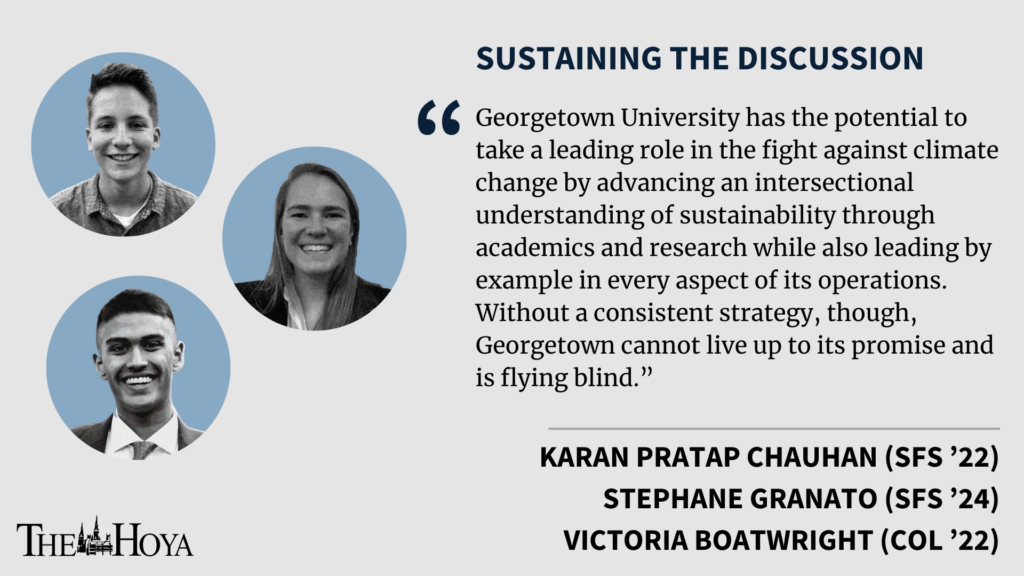Georgetown University desperately needs a coherent and comprehensive sustainability plan. To ensure its success, we need students to be involved every step of the way.
Georgetown has the potential to take a leading role in the fight against climate change by advancing an intersectional understanding of sustainability through academics and research while also leading by example in every aspect of its operations. Without a consistent strategy, however, Georgetown cannot fulfill this potential and is flying blind. Fortunately, the Georgetown Renewable Energy and Environmental Network has developed its own proposal to draft such a plan. The university administration should deepen its institutional commitment to Georgetown’s Jesuit value of “Care for Our Common Home” by implementing GREEN’s proposal, which calls on students, faculty and staff to collectively engage in the creation of a sustainability roadmap.
A sustainability plan must set concrete goals and expectations we as a community can use to hold Georgetown accountable. Without the accountability that accompanies a comprehensive plan, the Georgetown administration has a free pass when it comes to sustainability. It can proudly advertise one-off wins without making an organized effort to meet specific goals to address the climate crisis.
Furthermore, having a sustainability roadmap would make Georgetown’s green transformation more efficient, as actions taken by Georgetown relating to sustainability can work synergistically rather than independently. For instance, with a sustainability plan covering issues like waste, water, procurement and academic engagement, Georgetown could create initiatives that would decrease our negative impact on water resources by purchasing more sustainable cleaning supplies. Or students could engage in on-campus research with a Zero Waste officer to decrease student use of single-use plastics. A plan that covers all aspects of sustainability on campus and makes connections across initiatives is greater than the sum of many unconnected goals.
It is no surprise many comparable universities across the country have adopted long-term sustainability plans with annual updates: Brown, American, Richmond, Columbia, University of Pennsylvania and New York University have all done so. Not only do these universities have plans, but many actively collaborated with students to develop their plans. UPenn made targeted efforts to engage with students and incorporate their feedback in the process of creating their 2019 sustainability plan. NYU includes students on all of its administrative committees on sustainability.
In contrast, Georgetown lacks both a sustainability plan and systematic outreach to the student community. Much of the university’s sustainability goal-setting has come from top-down decision-making by administrators, which often comes as a surprise to students. For example, the GU-Origis contract — in which the university agreed to purchase half its electricity from a solar facility in Maryland — was announced without preliminary discussions with students, and the policy by the Board of Directors on divestment was released the day of the student body’s referendum.
Even when Georgetown committed to begin the process of drafting a plan — the university claimed to have an internal Sustainability Working Group in its 2017 master planning document — this process has not included the students most invested in making Georgetown more sustainable, and it has not produced any publicly published goals. While proposals to create sustainability working groups have been passed by GUSA, there has been no administrative follow-through.
Ironically, even in the top-down environment, students, not administrators, have largely driven and implemented on-the-ground changes that address the climate crisis. We see this in the student-led initiatives in the fight for divestment from fossil fuels, responsible solar energy, greater composting and recycling and other formal and informal engagements with sustainability on campus. This high level of student activism shows university initiatives must include students from the outset and throughout their implementation to avoid blind spots and meet the impetus of the climate crisis. Without students, there is no urgency.
GREEN’s sustainability plan would not be the first time Georgetown has moved toward inclusive climate action. In 2014, Georgetown organized a workshop to engage with faculty, staff and students on sustainability. This model of engagement is ideal and will yield lasting results if the administration follows through. However, Georgetown has not organized collaboration since. GREEN understands the university administration is occupied with challenges related to the COVID-19 pandemic, but the pandemic is not an excuse to refuse to engage productively with GREEN’s proposal or to wave off student involvement in favor of opaque and unaccountable internal processes.
We do not need to reinvent the wheel. Previous proposals, reports and planning documents, while outdated — the last planning document is from the 2011 fiscal year — provide a solid base of student and faculty input and research that should inform Georgetown’s work going forward. GREEN’s proposal adds to these papers by benchmarking goals and strategies in seven areas of sustainability set by peer institutions like American University, Columbia University and George Washington University to identify important standards Georgetown should meet. Drafting a sustainability plan is doable.
The university has a moral obligation to give students a central role in university sustainability planning, as our generation is the most threatened by the consequences of the climate crisis. The university must address GREEN’s proposal to draft a roadmap and create an open, accessible working group composed of any faculty, students and staff interested in joining. The university must also set a definite deadline — not just a hollow commitment to create yet another working group — to draft and release a comprehensive sustainability plan. At the very least, we should begin meeting on a bimonthly or a monthly basis. If Georgetown is to care for our common home, we need a transparent roadmap now to guide the way.
Karan Pratap Chauhan is a junior in the School of Foreign Service. Stephane Granato is a first-year in the School of Foreign Service. Victoria Boatwright is a junior in the College. Sustaining the Discussion appears online every other Friday.









